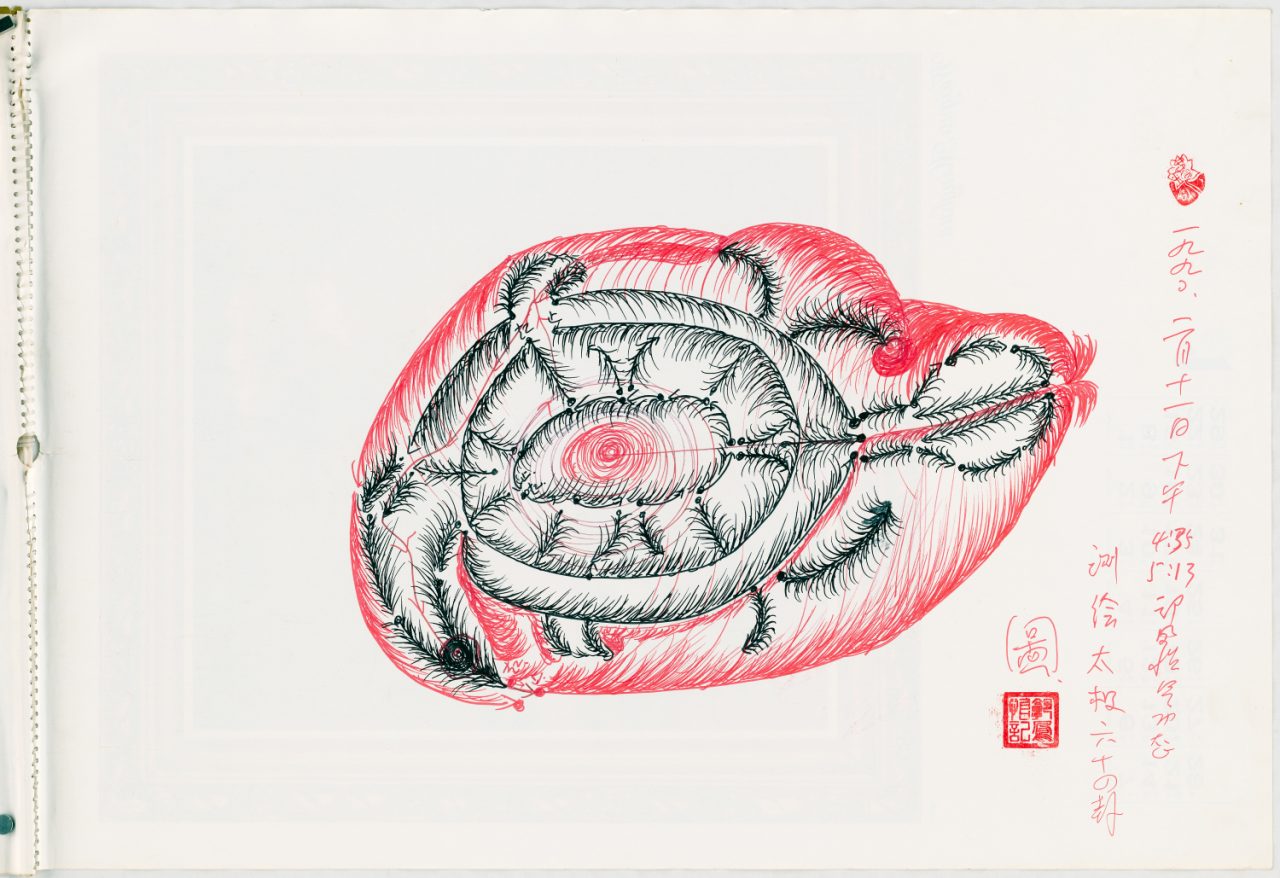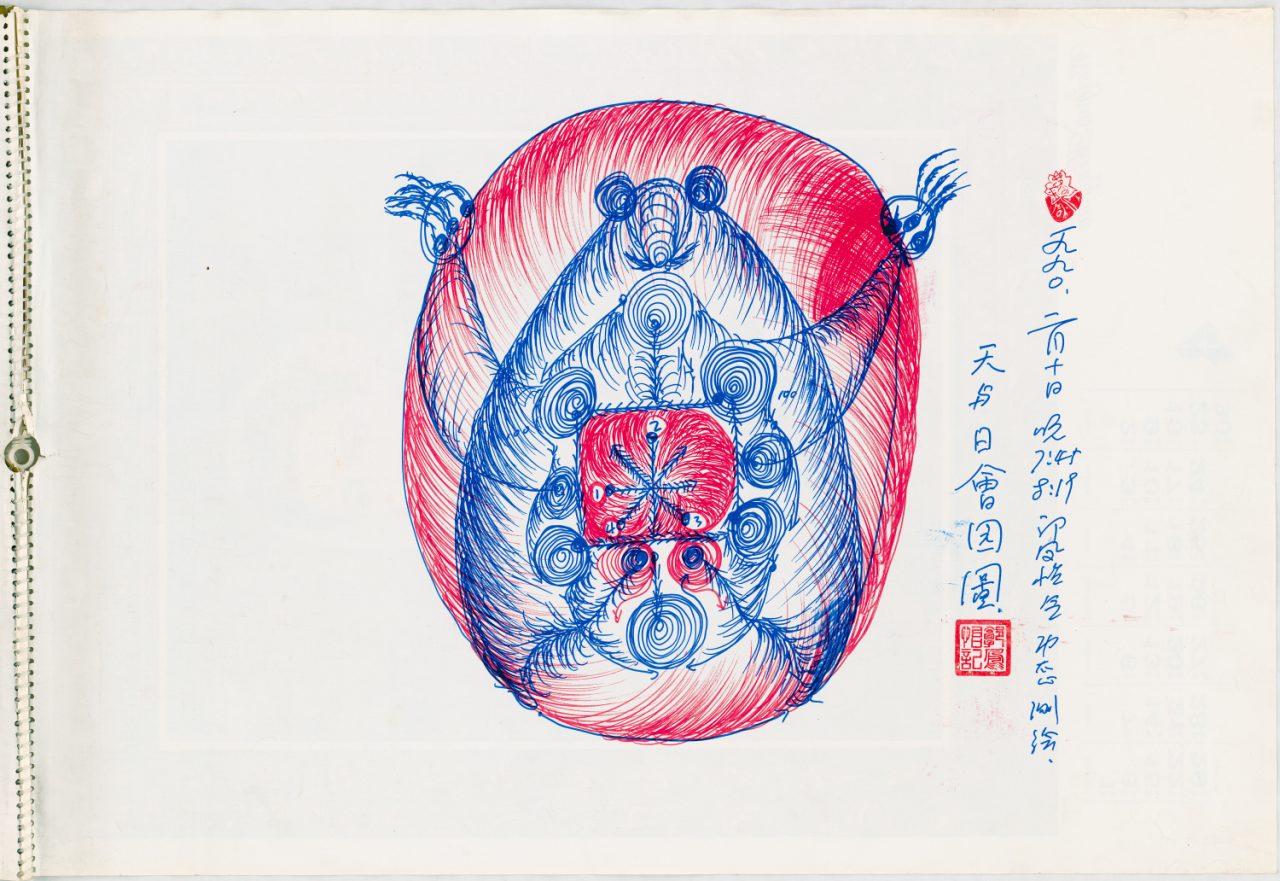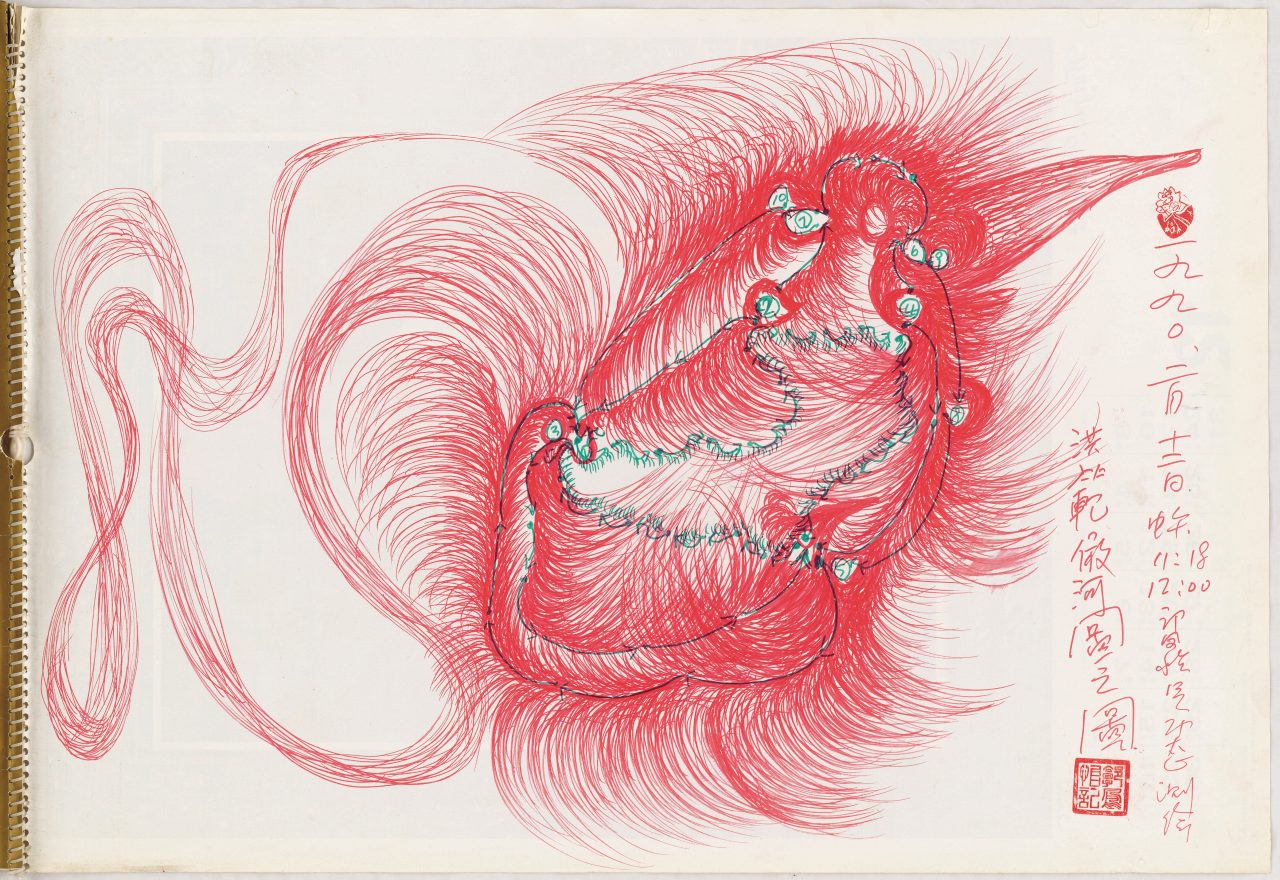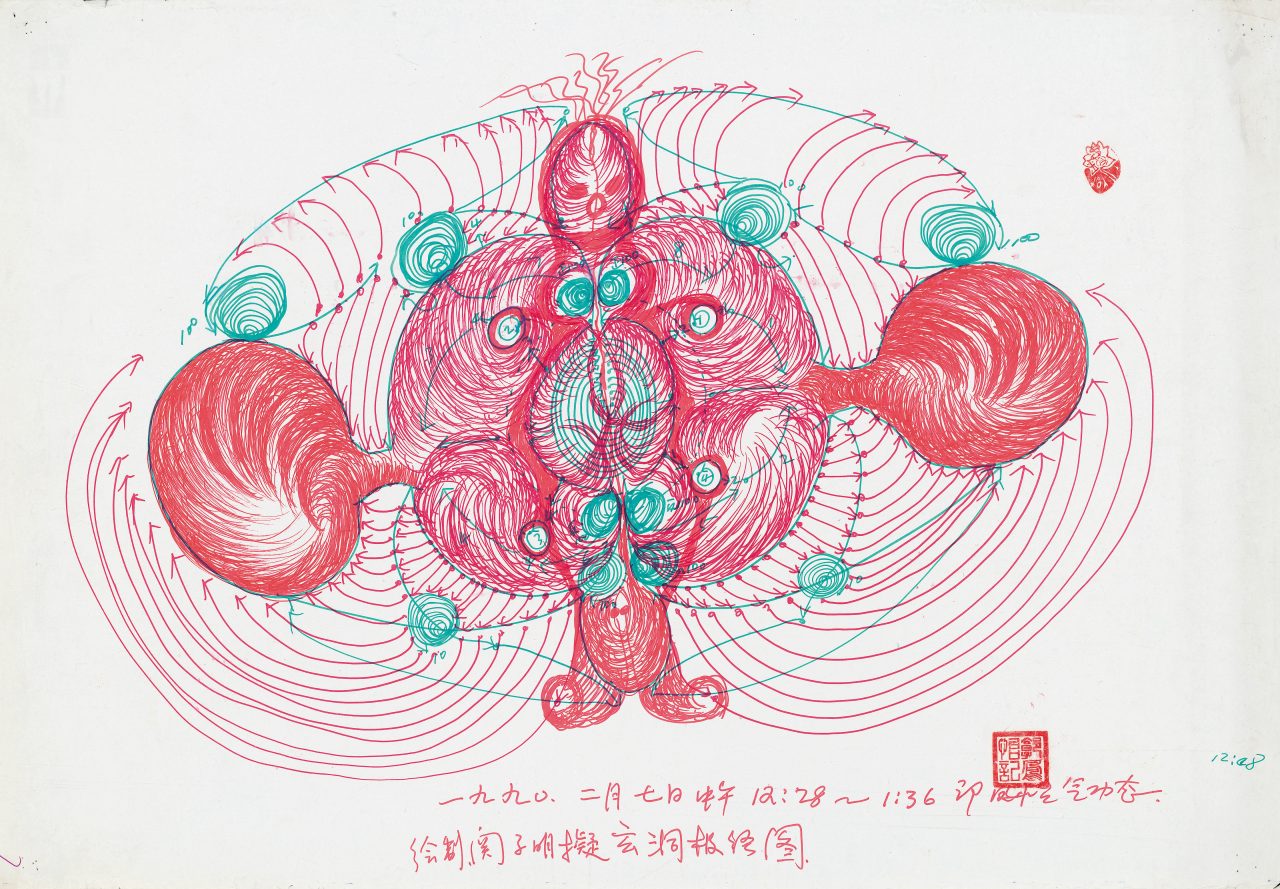Guo Fengyi: Cosmic Meridians (I)
Duration: 18 FEBRUARY 12:00 AM
- 17 MARCH 11:59 AM (CST), 2023
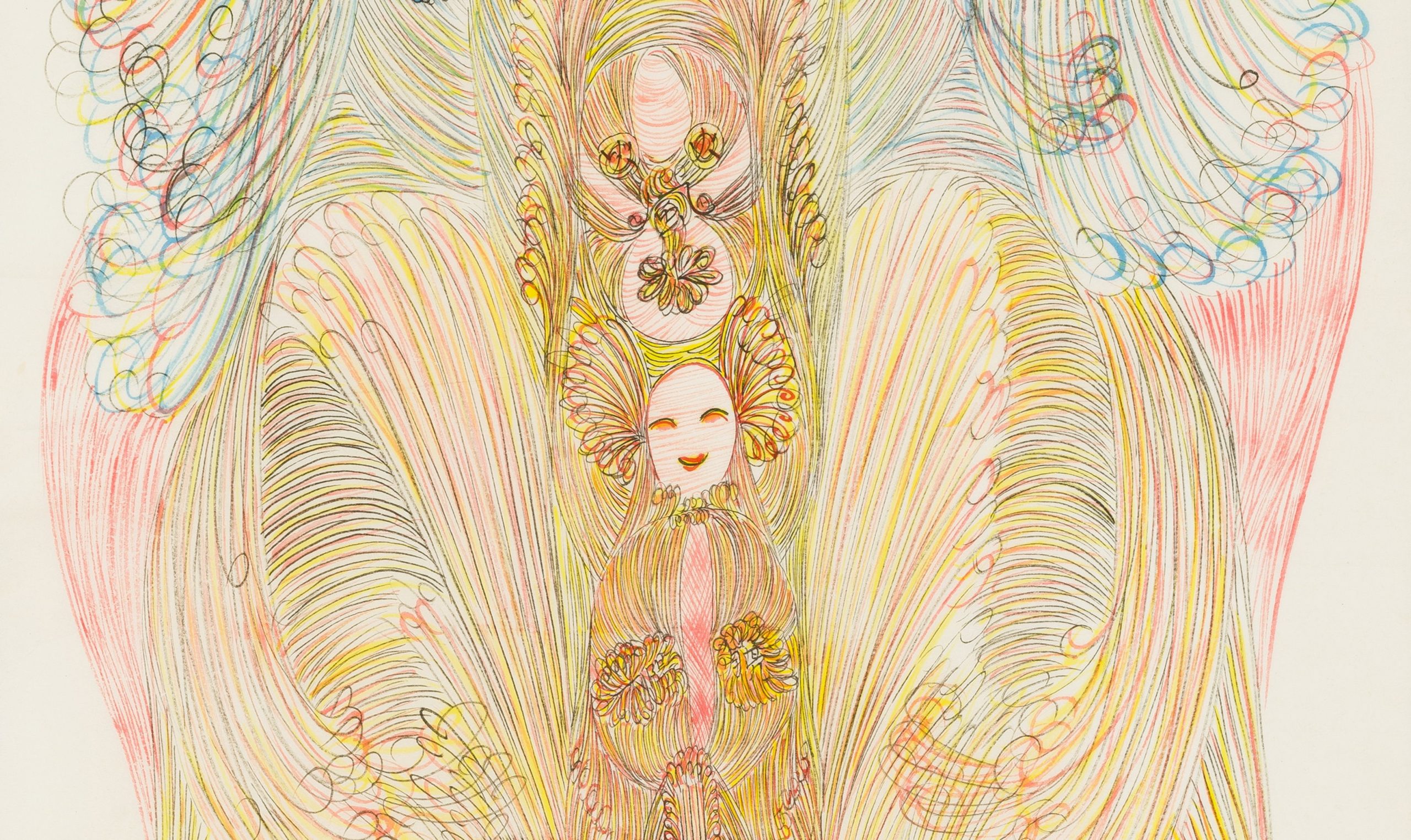
Although extant literature has ‘testified’ the relevance between Guo Fengyi’s works and the ancient cosmology, there remains an unarticulated point, that is, Guo is not ‘manifesting’ or ‘presenting’ the ancient cosmology but ‘utilising’ it to construct a new set of experience and logic. The sign of her construction does not depend on a certain kind of visual manifestation; its driving force is inherently and ultimately different from the latter.
The ‘vipassana’ and ‘clairvoyance’ are concepts and methods frequently referred to in Guo’s painting. As the mind and the universe are often believed to be inherently connected, the former reveals the instinct and impulse of humans inwardly, while the latter concludes the existence and laws of the world outwardly. Both of them are concerned with humans’ most primordial desire for knowledge. The employment of these two ways of seeing also explains why, in Guo’s paintings, from embryos to the cosmos, from the meridians to fengshui, from images of ancient times to the ones of the land and heaven, all these entities can be summoned and gathered across consciousness, time-space and matters.
--Excerpted from Wang Huan's Introduction for the exhibition Guo Fengyi: Cosmic Meridians
About Guo Fengyi
Guo Fengyi (1942–2010, Xi’an, China) is a self-trained female artist whose artistic practice articulates a particular journey of spiritual and metaphysical significance, belonging to an older generation whose embrace of Chinese folk culture imparts a unique knowledge of history, myth, and mystery. Her works on paper are composed of finely controlled brushwork that blend and weave into a composition of lustrous images; suggestions of both human figures and otherworldly beings.
Guo Fengyi began practicing Qigong (a traditional Chinese health maintenance practice that cultivates the qi energy within the body) as a way to alleviate illness. Accompanying her ever-deepening study into the philosophies of mysticism, she began having powerful visions that she felt compelled to give form to through drawing, as a way to adjust the balance between her body and her spiritual world. The subject matter of her works, as well as the concepts and physical structures she uses, comes from traditional Chinese systems of thought; cosmology, acupuncture energy maps, divination, sage kings, geomancy and dynastic grave sites—all of which have become dispensable in a modernizing China. Through her works, Guo Fengyi acts as a convergence point of traditional and contemporary thought, preserving cultural memories hidden deep within Chinese society. Through the physical act of drawing, Guo Fengyi charges the events of today’s world with a profound significance, both as an act of creativity as well as an act of everyday life.
Guo Fengyi’s first foray into the contemporary art world was her participation in the 2002 “Long March– A Walking Visual Display”, in which she produced site specific works at Lijiang, Yunnan Province, China, and collaborated with American artist Judy Chicago. Those works bore titles such as Lugu Lake, Lijiang, The Mosuo, Kunming, and If Women Ruled the World.
Guo Fengyi: Cosmic Meridians (I)
Duration: 18 FEBRUARY 12:00 AM
- 17 MARCH 11:59 AM (CST), 2023

Hetu and Luoshu, two mythical divination schemes from ancient China, appear recurrently as critical themes and references in Guo Fengyi’s practices. In fact, both images are systems of deduction derived from the pre-modern cosmology of ancient China concerning astrological changes in the universe, while Guo’s methodology is more like to observe and identify the logic and order of how the world works through self-constructed laws.
In this light, this exhibition borrows the divination rules of Luoshu. Using the actual orientation of Long March Space with its eight pillars zoning the exhibition space, it divides 45 pieces of paintings into nine groups according to the various key concepts embedded and locates them in nine positions. The nine key concepts are independent of but interpret each other, and the content of the paintings ranges from practicing qigong to cosmology, from The Book of Changes and Taoism to history and culture, and from the numbers of the human body to neurological points. Enlightenment, cognition, land, embryos…All these seemingly irrelevant objects return to a ‘question of perception’.
Although extant literature has ‘testified’ the relevance between Guo Fengyi’s works and the ancient cosmology, there remains an unarticulated point, that is, Guo is not ‘manifesting’ or ‘presenting’ the ancient cosmology but ‘utilising’ it to construct a new set of experience and logic. The sign of her construction does not depend on a certain kind of visual manifestation; its driving force is inherently and ultimately different from the latter.
The ‘vipassana’ and ‘clairvoyance’ are concepts and methods frequently referred to in Guo’s painting. As the mind and the universe are often believed to be inherently connected, the former reveals the instinct and impulse of humans inwardly, while the latter concludes the existence and laws of the world outwardly. Both of them are concerned with humans’ most primordial desire for knowledge. The employment of these two ways of seeing also explains why, in Guo’s paintings, from embryos to the cosmos, from the meridians to fengshui, from images of ancient times to the ones of the land and heaven, all these entities can be summoned and gathered across consciousness, time-space and matters.
--Excerpted from Wang Huan's Introduction for the exhibition Guo Fengyi: Cosmic Meridians
About Guo Fengyi
Guo Fengyi (1942–2010, Xi’an, China) is a self-trained female artist whose artistic practice articulates a particular journey of spiritual and metaphysical significance, belonging to an older generation whose embrace of Chinese folk culture imparts a unique knowledge of history, myth, and mystery. Her works on paper are composed of finely controlled brushwork that blend and weave into a composition of lustrous images; suggestions of both human figures and otherworldly beings.
Guo Fengyi began practicing Qigong (a traditional Chinese health maintenance practice that cultivates the qi energy within the body) as a way to alleviate illness. Accompanying her ever-deepening study into the philosophies of mysticism, she began having powerful visions that she felt compelled to give form to through drawing, as a way to adjust the balance between her body and her spiritual world. The subject matter of her works, as well as the concepts and physical structures she uses, comes from traditional Chinese systems of thought; cosmology, acupuncture energy maps, divination, sage kings, geomancy and dynastic grave sites—all of which have become dispensable in a modernizing China. Through her works, Guo Fengyi acts as a convergence point of traditional and contemporary thought, preserving cultural memories hidden deep within Chinese society. Through the physical act of drawing, Guo Fengyi charges the events of today’s world with a profound significance, both as an act of creativity as well as an act of everyday life.
Guo Fengyi’s first foray into the contemporary art world was her participation in the 2002 “Long March– A Walking Visual Display”, in which she produced site specific works at Lijiang, Yunnan Province, China, and collaborated with American artist Judy Chicago. Those works bore titles such as Lugu Lake, Lijiang, The Mosuo, Kunming, and If Women Ruled the World.


